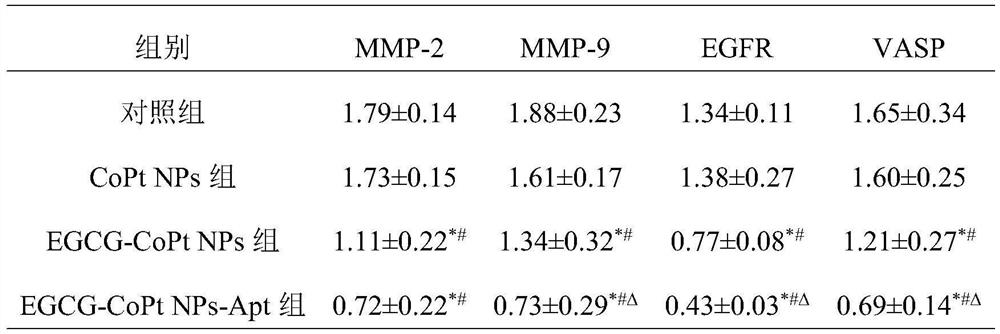EGCG-CoPt NPs-Apt nanoparticles as well as preparation method and application thereof
A nanoparticle, SH-AS1411 technology, applied in the direction of pharmaceutical formulations, medical preparations with non-active ingredients, medical preparations containing active ingredients, etc., to achieve the effects of reducing membrane penetration, inhibiting tumor cell metastasis, and reducing proliferation rate
- Summary
- Abstract
- Description
- Claims
- Application Information
AI Technical Summary
Problems solved by technology
Method used
Image
Examples
Embodiment E
[0024] Preparation of Example EGCG-CoPt NPs Nanoparticles
[0025] Step (1) prepares EGCG-CoPt NPs nanoparticles:
[0026] 5 mL of 1M CoCl 2 solution with 10mL 0.5M K 2 PtCl 4 The solutions were mixed to obtain a mixed solution. After shaking and shaking in a water bath at 25°C for 30 minutes, 0.125 g of EGCG was added, and the water bath was continued to shake and shake for 30 minutes; then, 1 mL of 0.6M sodium borohydride solution was added under ultrasound to react for 30 minutes, centrifuged, and removed. Washing with deionized water for 3 times and suspending with deionized water to obtain EGCG-CoPt NPs nanoparticle suspension.
[0027]Step (2) prepares EGCG-CoPt NPs-Apt nanoparticles:
[0028] Add 1 L of thiol nucleic acid aptamer SH-AS1411 to the EGCG-CoPt NPs nanoparticle suspension prepared in step (1), and incubate overnight at 4°C to obtain the EGCG-CoPt NPs-Apt nanoparticle suspension.
[0029] The EGCG-CoPt NPs-Apt nanoparticles prepared by the present invent...
experiment example 1
[0033] Experimental example 1 Study on the inhibitory effect of EGCG-CoPt NPs-Apt nanoparticles on the proliferation of triple-negative breast cancer cells MDA-MB-231
[0034] (1) Experimental steps:
[0035] The experimental group was divided into three groups, namely CoPt NPs group, EGCG-CoPt NPs group and EGCG-CoPt NPs-Apt group. Take the MDA-MB-231 cells cultured to the logarithmic growth phase, and adjust the cell concentration to 5×10 5 cells / mL, take 100 μL cell suspension and inoculate into 96-well culture plate, place at 37°C, volume fraction 5% CO 2 After incubating in the incubator for 6 h, the fresh medium was replaced. According to different groups, 50 μL of CoPt NPs nanoparticle suspension, 50 μL of EGCG-CoPtNPs-Apt nanoparticle suspension, and 50 μL of EGCG-CoPt NPs nanoparticle suspension were added to the experimental group, and 50 μL of fresh medium was added to the blank control group. Set up 3 parallels. Continue to place at 37°C, 5% volume fraction CO ...
experiment example 2
[0041] Experimental example 2 Study on the inhibitory effect of EGCG-CoPt NPs-Apt nanoparticles on the migration of triple-negative breast cancer cells MDA-MB-231
[0042] Take the MDA-MB-231 cells cultured to the logarithmic growth phase, and adjust the cell concentration to 5×10 5 individual / mL. Add 500 μL of RPMI 1640 medium containing 10% fetal bovine serum to the lower chamber of the Transwell chamber, and add 100 μL of cell suspension to the upper chamber. The experimental group was added 50 μL CoPt NPs nanoparticle suspension, 50 μL EGCG-CoPtNPs-Apt nanoparticle suspension, 50 μL EGCG-CoPt NPs nanoparticle suspension according to the different groups, and the control group was added 50 μL fresh medium. Next, place at 37°C, 5% volume fraction CO 2 Cultivate in an incubator for 24 hours, discard the medium, fix with absolute ethanol, and stain with 1 g / L crystal violet for 10 minutes each. Five fields of view were randomly selected under a magnification of 400 times, a...
PUM
 Login to View More
Login to View More Abstract
Description
Claims
Application Information
 Login to View More
Login to View More - R&D
- Intellectual Property
- Life Sciences
- Materials
- Tech Scout
- Unparalleled Data Quality
- Higher Quality Content
- 60% Fewer Hallucinations
Browse by: Latest US Patents, China's latest patents, Technical Efficacy Thesaurus, Application Domain, Technology Topic, Popular Technical Reports.
© 2025 PatSnap. All rights reserved.Legal|Privacy policy|Modern Slavery Act Transparency Statement|Sitemap|About US| Contact US: help@patsnap.com



